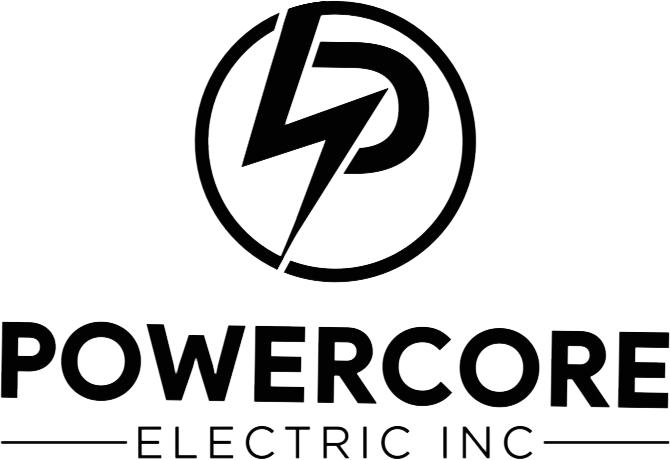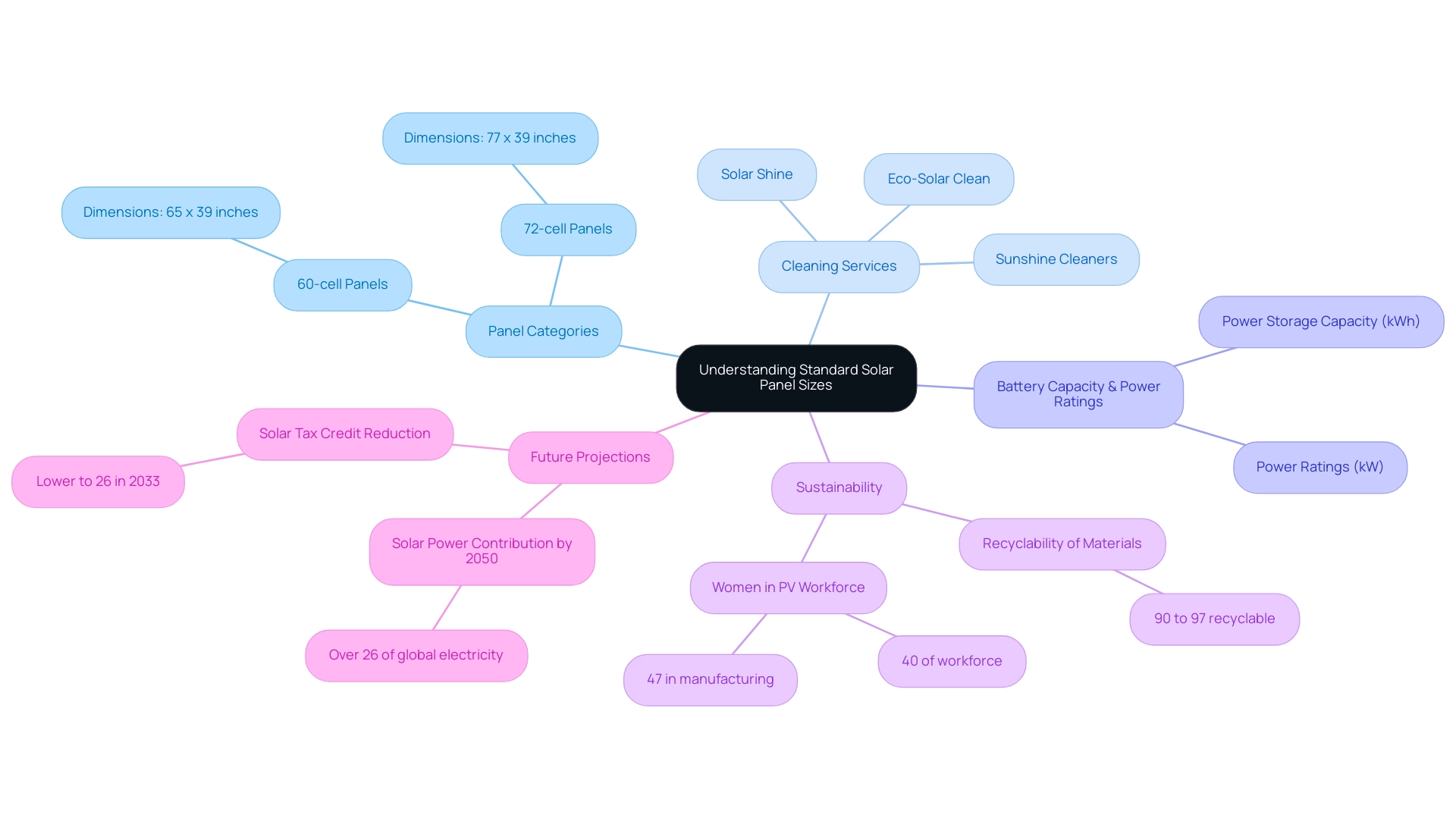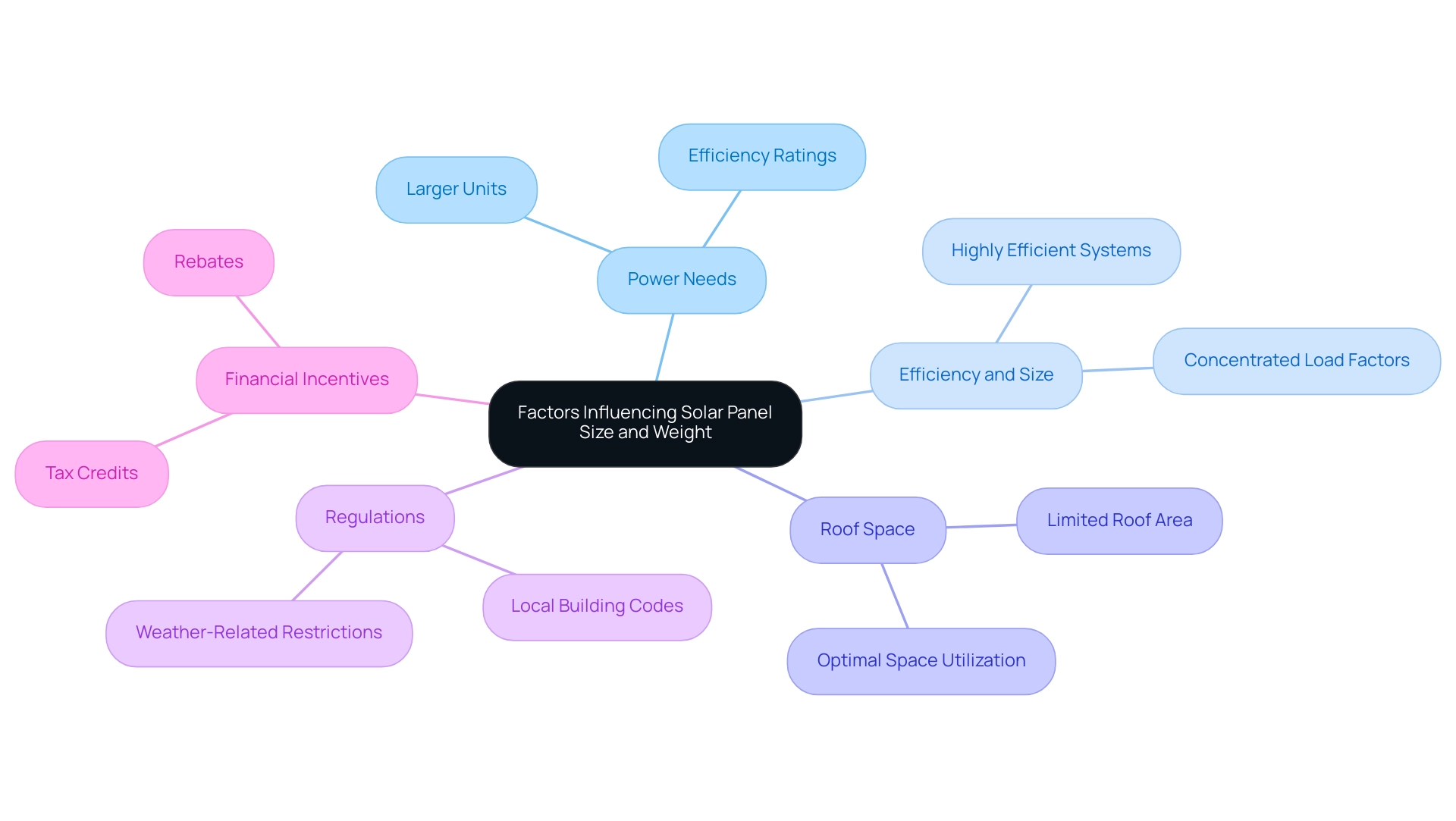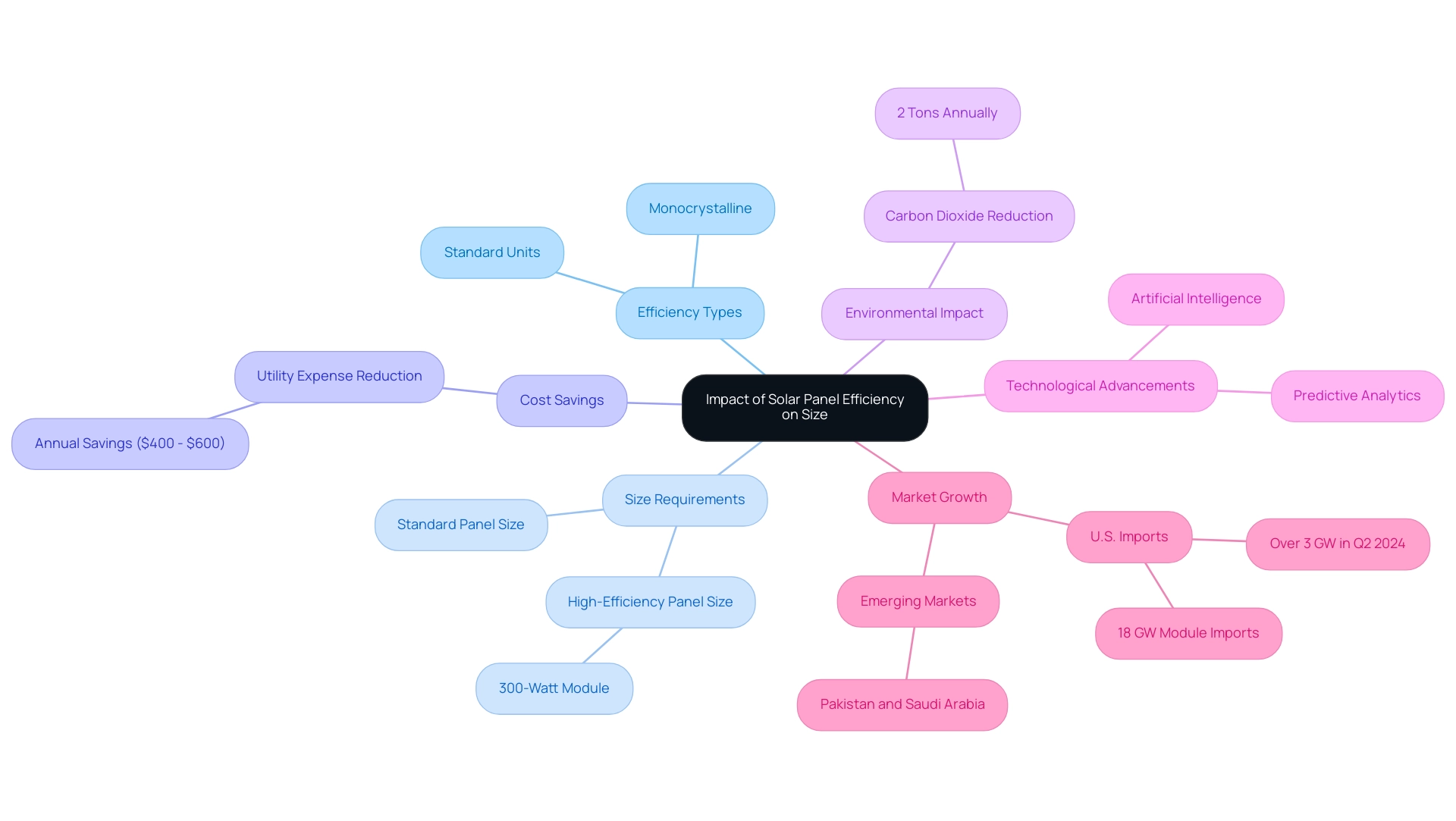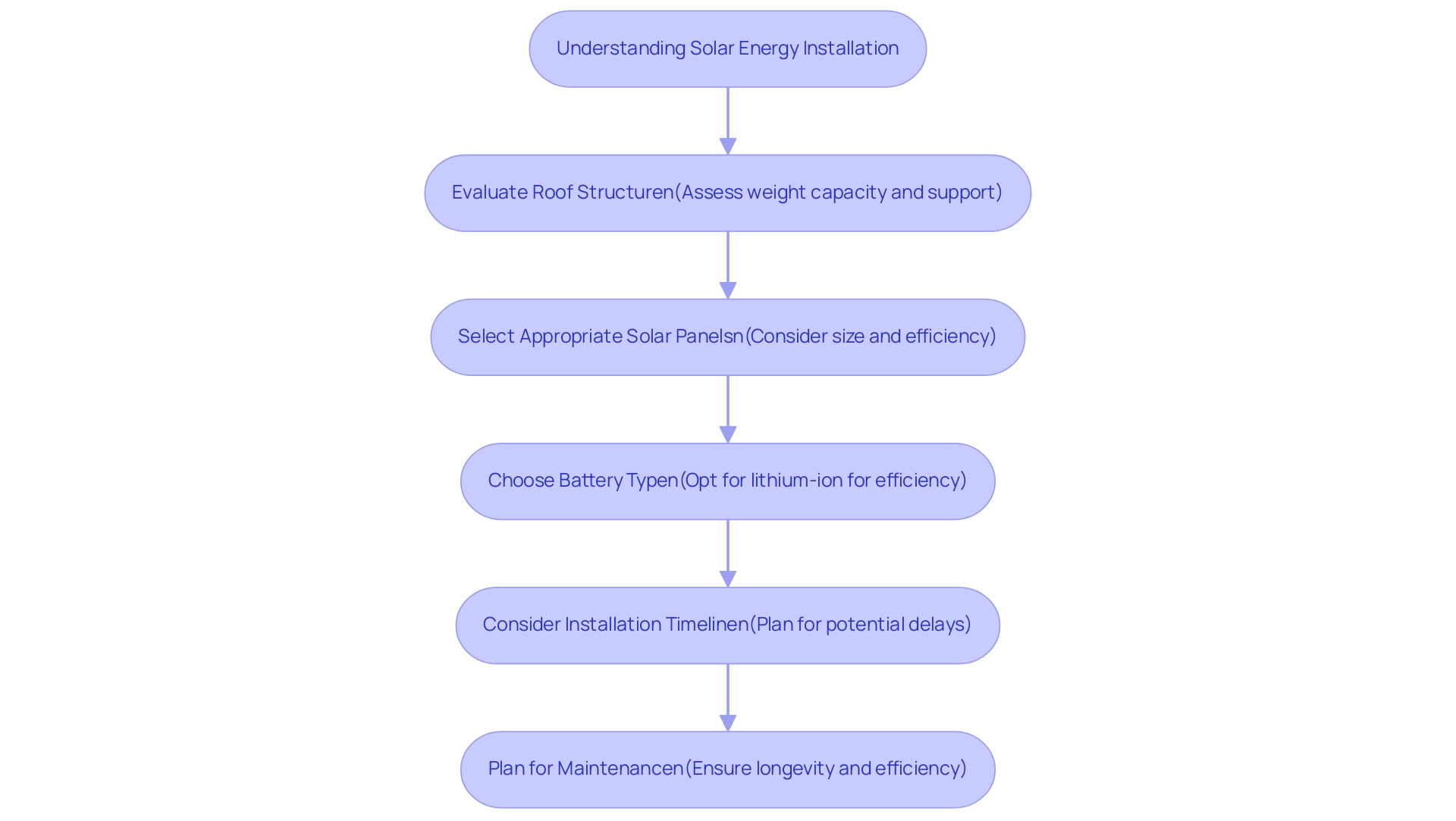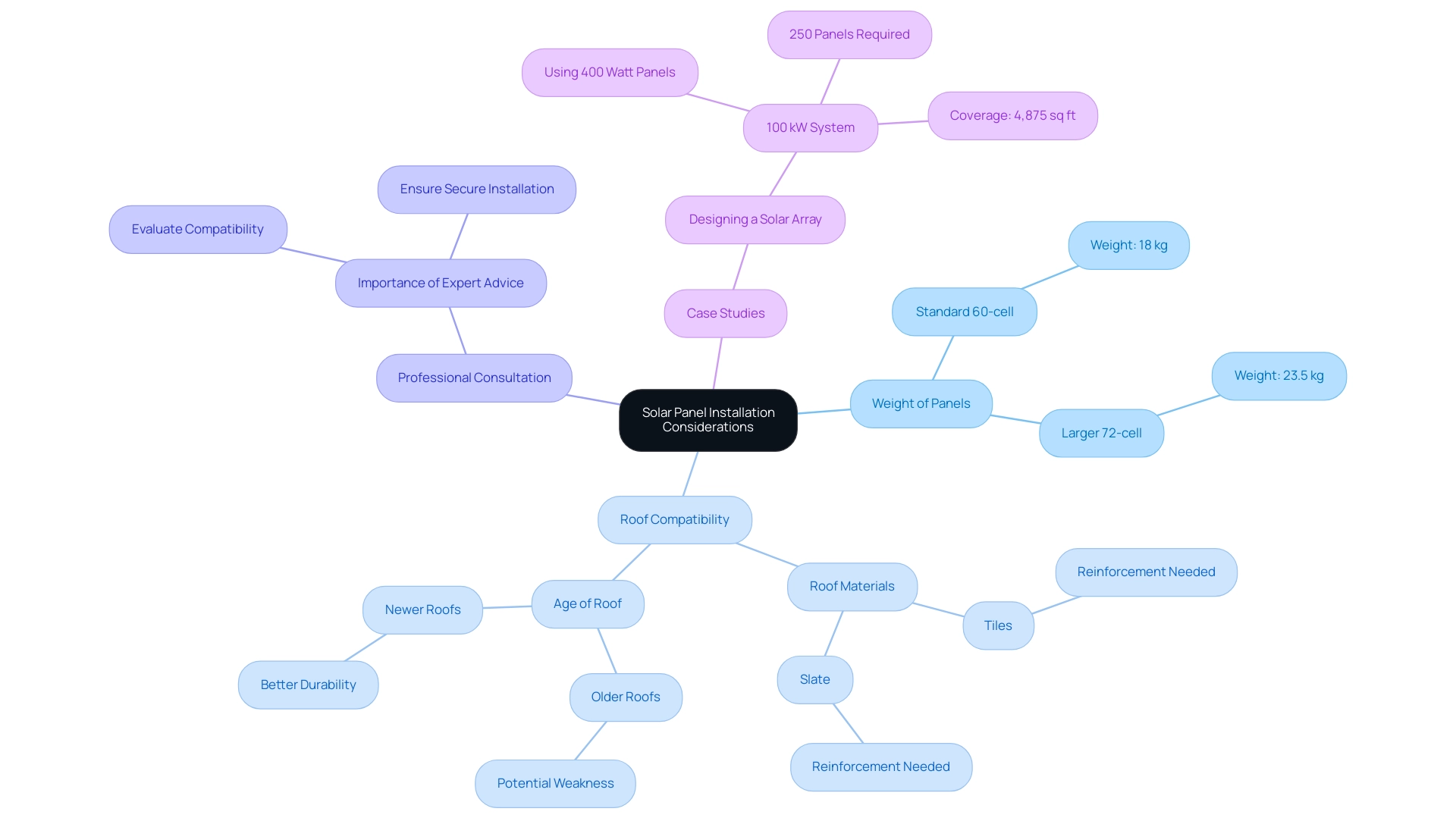Overview
The article focuses on the size of solar panels, specifically detailing the standard dimensions of 60-cell and 72-cell units and their implications for homeowners considering solar energy installation. It underscores that understanding these sizes is crucial for effective planning and installation, as they affect how many panels can fit on a roof and influence overall energy efficiency, with larger, more efficient panels being beneficial for maximizing power production in limited spaces.
Introduction
Choosing to harness solar energy for a home can feel like navigating a maze of options, sizes, and specifications. With the solar industry booming and more homeowners looking to make eco-friendly choices, understanding the ins and outs of solar panel sizes is essential.
From the dimensions of 60-cell and 72-cell panels to the impact of efficiency on space utilization, this article will guide readers through the critical factors influencing their solar panel decisions. It will also touch on how aesthetics, installation considerations, and weight compatibility play a significant role in selecting the right system.
As the journey toward sustainable energy continues, gaining clarity on these elements not only empowers homeowners but also contributes to a greener future.
Understanding Standard Solar Panel Sizes
When evaluating photovoltaic modules for your residence, it’s crucial to acknowledge the size of one solar panel, as the standard dimensions generally fall into two main categories: 60-cell and 72-cell units. A 60-cell photovoltaic module typically measures about 65 inches by 39 inches (or roughly 5.4 feet by 3.25 feet), while a 72-cell unit is larger, averaging around 77 inches by 39 inches (approximately 6.4 feet by 3.25 feet). Understanding these dimensions will help you determine how many panels will fit on your roof and how to best arrange your solar system.
As you embark on this journey, consider taking advantage of top-rated solar panel cleaning services like:
- Sunshine Cleaners
- Solar Shine
- Eco-Solar Clean
These services focus on eco-friendly practices and waterless techniques to maintain efficiency.
It’s also essential to comprehend battery capacity and power ratings for effective resource management. Power storage capacity, measured in kilowatt-hours (kWh), indicates how much electricity a cell can hold, while power ratings, expressed in kilowatts (kW), determine how much electricity can be utilized at once. Selecting the suitable power storage capacity guarantees that your household’s power requirements are fulfilled, particularly during peak demand times.
Furthermore, various manufacturers may provide somewhat different sizes, so it’s always prudent to verify the specific product specifications before making your choice. As the renewable energy sector continues to expand—projected to provide over 26% of worldwide electricity by 2050—homeowners are urged to invest wisely in energy solutions. Additionally, about 90% to 97% of panel materials are recyclable when they reach the end of their lifecycle, emphasizing the sustainability aspect that resonates with eco-conscious homeowners.
Barry Elad, a senior writer, emphasizes this by stating, ‘About 90% to 97% of power material is recyclable and can be reused for other purposes when it breaks down.’ Furthermore, it’s important to recognize that women represent almost 40% of the workforce in the PV industry, with 47% in manufacturing, highlighting diversity and workforce engagement within this growing sector. So, as you navigate your renewable power journey, remember that not only are you making a wise investment, but you’re also contributing to a more sustainable future.
Factors Influencing Solar Panel Size and Weight
When considering solar systems for your home, several key factors come into play regarding the size of one solar panel and its weight. Comprehending your power needs is crucial—larger units can produce more electricity, making them especially advantageous for homes with greater power usage. For example, if your residence greatly depends on electrical devices, choosing larger units or those with superior efficiency ratings may enhance your power output without requiring a vast collection of smaller units.
This is particularly significant for eco-conscious homeowners seeking to enhance their solutions.
Solar modules function by transforming sunlight into electricity via photovoltaic cells. When sunlight hits these cells, it generates direct current (DC) electricity, which is then converted into alternating current (AC) electricity by an inverter, making it usable for your home. Comprehending this process can assist homeowners in making educated choices regarding their requirements and selection of systems.
According to the Center for Sustainable Systems, the “Photovoltaic Energy Factsheet” discusses various aspects, including the size of one solar panel (Cite As Center for Sustainable Systems, University of Michigan). In 2024, understanding your power requirements is essential for choosing the appropriate size of one solar panel. Additionally, consider your available roof space; homeowners with limited roof area might prefer fewer, larger units, which can be compared to the size of one solar panel, that provide sufficient energy without overcrowding the roof.
Utilizing highly efficient photovoltaic systems can decrease the quantity of modules required while ensuring concentrated load factors are maintained.
Local building codes and regulations also play a significant role in your choices, often setting restrictions on panel size and weight, particularly in regions prone to severe weather. Consulting with a local energy installation expert can help you navigate these requirements and assess your specific needs. Significantly, in 2022, 32% of market sales from renewable sources were linked to photovoltaic systems, emphasizing its increasing significance in the power sector.
Homeowners can also benefit from various government programs that provide financial incentives for panel installation, such as tax credits and rebates. These programs can greatly decrease the initial outlay and enhance the overall return on investment for photovoltaic systems. Comprehending these elements is essential for a successful renewable power journey.
With insights from experts like Fenice Energy, you can make informed decisions about your solar installation, ensuring that you optimize both energy output and space utilization while enjoying the benefits of government programs that support eco-friendly energy solutions.
The Impact of Solar Panel Efficiency on Size
Solar cell efficiency is a critical factor that determines how effectively it can convert sunlight into usable electricity. For instance, monocrystalline modules are known for their high efficiency, allowing them to produce more electricity per square foot than their less efficient counterparts. This efficiency becomes especially significant for eco-aware homeowners with restricted roof space, as investing in these high-efficiency systems can assist in reaching sustainability objectives without the necessity to cover the whole roof, especially when considering the size of one solar panel.
To illustrate, consider that the size of one solar panel, specifically a high-efficiency 300-watt module, is approximately 17.5 square feet; in contrast, a standard unit with lower efficiency may require around 20 square feet to generate the same amount of electricity. Thus, choosing a more efficient panel can significantly minimize the space required for installation, especially considering the size of one solar panel, making it a smart choice for maximizing power production in constrained areas while also reducing utility expenses. With the latest advancements in photovoltaic technology in 2024, including predictive analytics and artificial intelligence, homeowners can benefit from options that not only enhance power output but also fit seamlessly into their residential setups.
Moreover, as reported, water heating systems powered by the sun can save homeowners between $400 to $600 each year on utility expenses. These systems also demonstrate high thermal efficiency ratings, converting a significant portion of sunlight into usable heat, and greatly diminish reliance on conventional energy sources, decreasing greenhouse gas emissions. Notably, the Environmental Protection Agency indicates that utilizing water heating systems can prevent 2 tons of carbon dioxide from entering the atmosphere each year, comparable to not operating a vehicle for four months.
Additionally, the United States imported over 3 GW of photovoltaic cells in Q2 2024, reflecting the growing demand for efficient energy solutions. As we progress, understanding the size of one solar panel in residential photovoltaic system sizing and the advantages under the 200% rule will be essential for homeowners contemplating renewable solutions.
Considering Aesthetics and Size
When discussing photovoltaic systems, many homeowners inherently have preferences regarding their look on rooftops, as aesthetics can influence the decision-making process. A recent survey (n = 601) revealed that public attitudes towards renewable energy are significantly influenced by how these installations fit into the overall appearance of a home. While larger energy collectors might provide enhanced efficiency, they can also become quite noticeable in the overall design.
Thankfully, manufacturers are now providing energy panels in a variety of colors and designs, making it easier for you to find options that blend seamlessly with your roof. At Powercore Electric, we understand the unique electrical and renewable energy needs of California communities, ensuring that your system not only performs efficiently but also complements your home’s charm. Numerous pleased clients have conveyed how our customized solutions have improved their home’s visual attractiveness while offering savings.
For example, one client remarked, “The energy systems not only lowered my utility expenses but also appeared amazing on my roof!” Additionally, the arrangement of these panels matters too; a neat and orderly grid pattern can create a more attractive visual than a random layout. According to Mohammed bin Rashid Al Maktoum, “it has been shown that MBR Solar Park achieves several SDGs such as SDG 11: sustainable cities and communities,” which underscores the importance of integrating aesthetics with broader sustainability goals.
To ensure your energy system enhances your home’s curb appeal while being energy-efficient, consider having a conversation with your installer about aesthetic choices. At Powercore, we are committed to a customer-first approach, helping you reflect your personal style and commitment to sustainability. Moreover, a case study on factors influencing PV adoption in Lahore highlights how aesthetic preferences can significantly impact consumer choices and adoption rates, emphasizing the need for governmental and non-governmental organizations to contribute evidence regarding the ecological impacts of installations.
Reach out to us today for a complimentary, customized estimate and allow us to assist you in discovering the ideal energy solution for your home!
Installation Considerations Based on Size
When considering solar energy installation, understanding how solar systems function is crucial. Solar modules convert sunlight into electricity through photovoltaic cells, which produce direct current (DC) electricity. An inverter then converts this DC electricity into alternating current (AC) electricity, which powers your home.
The dimensions of the sections, such as the size of one solar panel, play a crucial role in the overall planning process. Bigger sections can necessitate extra structural support, especially on older structures that may not be built to handle the additional weight. It’s essential for homeowners to evaluate if their roof can support the weight of the structures, particularly when considering snow buildup or debris.
Furthermore, choosing the appropriate battery is crucial for effective power storage, assisting you in maximizing your renewable investment. For instance, lithium-ion batteries are highly recommended due to their efficiency and longevity. The size of one solar panel may lead to extended installation timelines when larger panels are used, as they might necessitate extra equipment or adjustments to the inverter system, which can impact the total project costs.
In 2023, the deployment of 3 GW of new storage systems alongside photovoltaic installations highlights the growing trend and relevance of energy solutions. Working closely with your installer is essential; they can assist you in navigating these considerations, ensuring that your energy setup is safe, efficient, and customized to your home’s specific needs. As Ben Zientara, a policy analyst for renewable energy, emphasizes, ‘Understanding these installation dynamics is essential for making informed decisions in your energy journey.’
Moreover, regular maintenance and innovative cleaning solutions are important for maintaining efficiency and longevity. For instance, a case study from a homeowner in Colorado showed how the installation of anti-reflective coatings on their energy systems minimized glare and improved energy output, enhancing overall satisfaction. Case studies demonstrate how homeowners have minimized aesthetic and visual effects of photovoltaic systems, illustrating how design elements can enhance efficiency and reduce glare, ultimately improving homeowner satisfaction.
Understanding Solar Panel Weight and Roof Compatibility
When considering solar systems for your home as an eco-conscious homeowner, it’s important to recognize that their weight can vary significantly based on the model and type. Most panels typically weigh between 40 to 50 pounds, which indicates that the size of one solar panel is roughly 18 kg for a standard 60-cell, 1.7m² panel and around 23.5 kg for a larger 72-cell, 2.3m² module. This variation not only affects installation but also impacts the structural integrity of your roof.
In fact, in 2022, solar energy accounted for 32% of market sales from renewable energy mechanisms, underscoring its growing importance. Roof materials play a crucial role in this process; for instance, tiles or slate may require additional reinforcement to support the weight of heavier panels. Furthermore, the age of your roof is a key consideration—older roofs might lack the durability of newer constructions, making it essential to consult with a roofing professional for a thorough evaluation.
For Long Beach renters, exploring local solar programs can provide insights into accessible solar options and potential incentives. Additionally, when it comes to energy storage, consider options like lithium-ion batteries, which are known for their efficiency and longevity, making them suitable for residential use. A practical example can be found in the case study titled ‘Designing a Solar Array,’ which emphasizes the significance of determining the quantity of modules required based on their weight and compatibility with your structure.
Jeff Sykes, CEO of Solar Choice, stresses that collaborating closely with solar installation specialists is essential for evaluating compatibility and ensuring your selected panels are securely supported. A well-planned installation not only guarantees efficiency but also preserves the longevity of your roof, making it a smart investment for sustainable living.
Conclusion
Understanding the various factors influencing solar panel choices is essential for any homeowner embarking on the journey toward sustainable energy. From the standard panel sizes of 60-cell and 72-cell options to the critical importance of efficiency and aesthetics, each element plays a vital role in optimizing energy production and enhancing the look of your home. By grasping the dimensions, weight considerations, and installation requirements, homeowners can make informed decisions that align with their energy needs and personal preferences.
Furthermore, recognizing the environmental benefits of solar energy cannot be overstated. Not only do these systems contribute to a reduction in carbon emissions, but they also promote sustainability through the recyclability of materials used in solar panels. As the solar power industry continues to expand, understanding these aspects empowers homeowners to invest wisely, ensuring that their choices not only meet their energy demands but also support a greener future.
In conclusion, embracing solar energy is not merely about reducing utility bills; it’s about participating in a global movement toward sustainable living. With the right knowledge and guidance, homeowners can confidently navigate the complexities of solar panel selection, paving the way for a brighter, more eco-friendly home and community. The journey may seem daunting, but the rewards are well worth the effort, contributing to both personal and environmental well-being.
